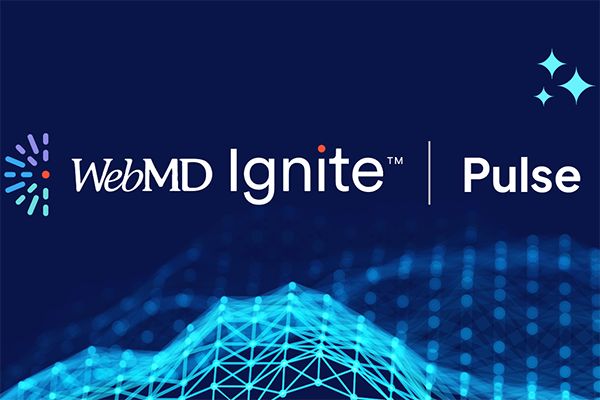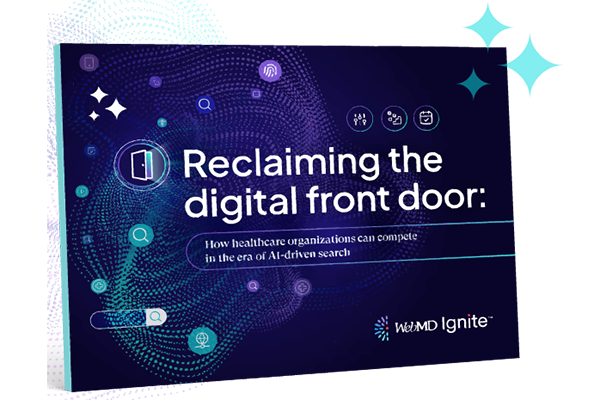AI in healthcare: Structured content is healthcare's answer to AI disruption
Healthcare marketing is undergoing its most significant transformation since the rise of digital channels two decades ago. Artificial intelligence is redefining how patients and providers discover and engage with healthcare brands, with AI Overviews (AIOs) in search emerging as a disruptive new gateway to care.
Healthcare queries now trigger AIOs at rates of 63-84% — the highest of any industry. When these AI-generated summaries appear, organic click-through rates (CTRs) can drop by up to 84%. Perhaps most telling, 69% of all Google searches now result in zero clicks, with users getting their answers directly on the search results page.¹
For health systems and payers, this shift directly impacts visibility, acquisition, and digital engagement strategies. If consumers no longer need to click through to your website to get answers, your digital presence must work harder in the moments when they do engage. Traditional performance funnels built around keyword rankings and referral traffic are giving way to a new reality where answers are synthesized, clicks are optional, and visibility increasingly depends on structured, machine-readable content.
WebMD Ignite has taken the lead in helping healthcare partners navigate this transformation and adapt strategies for an increasingly AI-driven world. The approach combines deep healthcare expertise with cutting-edge AI capabilities to help healthcare providers thrive in a new digital environment.
Your content still matters
While the shift to AIOs has reduced traditional CTRs, it doesn't diminish the importance of authoritative healthcare content. Trusted, quality sources are more valuable than ever in this new search landscape, but how content should be structured and optimized has changed.
The key is adopting a modular, structured approach to content creation. Single, static pieces should be broken into smaller, reusable components and organized as independent parts such as text, video, and images with rich metadata. This structured content approach addresses two critical criteria: it makes content machine-readable for AI systems while also making it more adaptable for multiple channels and formats.
Healthcare partners that leverage structured content collections can gain a significant advantage. The same clinically reviewed content that comprises a traditional web article can be dynamically assembled for different audiences while maintaining accuracy and consistency across each touchpoint.
This is where structured, clinically reviewed content becomes the infrastructure for effective marketing material. Healthcare organizations need content that flows seamlessly into the moments that matter — when a provider is documenting a visit, when a patient opens their portal after a diagnosis, or when a care manager identifies someone at risk.
While most healthcare systems are implementing ambient AI tools and seeing significant amounts of time saved by providers, the next competitive advantage lies in intelligent content integration. As one Chief Clinical Officer noted, "It's going to come down to an integration game – who(ever) has the best integration wins."
Building trust in an AI-first world
As AI-generated content proliferates across the internet, audiences have grown wary of inaccurate or unvetted medical information. WebMD Ignite partners have an opportunity to distinguish themselves from the growing prevalence of AI “slop,” with clinically reviewed content collections that serve as the foundation for AI strategy.
When search engines generate overviews and summaries, they rely heavily on authoritative, high-quality source content that meets Google's Experience, Expertise, Authoritativeness, and Trustworthiness (E-E-A-T) standards. WebMD Ignite content is trusted by more than half of U.S. hospitals and consistently meets these criteria. It also positions healthcare organizations as the authorities that shape AI-delivered answers to patients and healthcare consumers.
Partners can tap into this massive bank of vetted content to generate new assets and adapt them on demand. Powered by its foundation, WebMD Ignite Digital Experience Engine takes healthcare marketing further with automated, SEO-friendly page creation — including location-based provider listings — while ensuring its original clinical accuracy.
Looking forward: Implementing AI to evolve healthcare marketing
The rise of AI in healthcare marketing signals a shift toward more personalized, efficient, and effective consumer engagement. For AI to be successful in this space, it must be held to the same standards as trusted health content — delivering clinical accuracy at scale while meeting stringent data protection requirements.
Additional best practices:
- Optimize for influence, not just impressions — Invest in and deliver authoritative content that AI systems will reference and cite by prioritizing well-organized, clinically accurate information
- Leverage first-party data strategically — Use AI to enhance targeting while maintaining privacy standards
- Prepare for integration challenges — Organizations with the best AI integrations will have competitive advantages
What’s next in our AI series
This is the second installment in our “AI in healthcare” series. In the first article we separated myth from fact, showing how AI is already reshaping how care is delivered, explained, and experienced. Next, we’ll provide practical strategies for using AI in content creation — approaches that save time without sacrificing clinical accuracy or clarity.
AI is not a distant promise — it’s here, evolving quickly, and already changing how care is delivered and experienced. The challenge now is adopting it responsibly, with precision and purpose.
SOURCES
- Data from WebMD Ignite webinar "AI disruption meets digital demand: Why your website is still your strongest signal", citing research from BrightEdge, Seer Interactive, and SimilarWeb (2024-2025).





